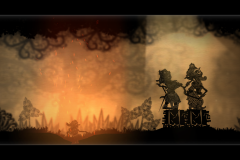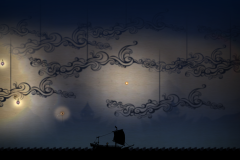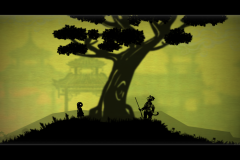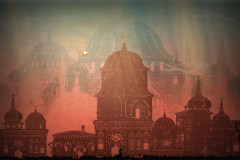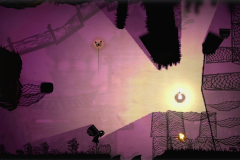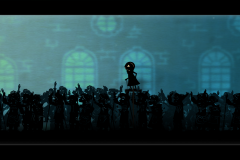In what is easily one of the most unique and fascinating video games I have ever played of 2020, Australian Indie developer Shadowplay Studios, along with the help and assistance of Sweaty Chair Studio, these developers have created Projection: First Light, a two-dimensional platformer that was initially released on Apple Arcade, but has now been given a wider release on home consoles this year.
Projection: First Light’s story begins with a little girl called Greta, who after successfully catching a butterfly that she is drawn to in her hometown, causes accidental chaos while doing so, such as breaking a shopkeeper’s items or crashing a policeman’s car, which result in her getting into trouble with her parents. When the butterfly manages to escape her clutches, this causes Greta to run away from home to reclaim it, embarking on quite the adventure with levels spread across different countries such as Indonesia, Greece, China, Turkey and 19th Century England.
What makes Projection: First Light unique is both in its way of storytelling and how it looks. No words are ever spoken in this game and instead, the game’s story is presented through imagery and emotional cues. The entirety of the game’s graphics and style is played out in a shadow puppet/lightbox style, most likely influenced from ancient Asia times. It makes for such a unique feel and look to the game and is easily the strongest point of Projection. It is simplistic in its portrayal, yet absolutely gorgeous and very well done.
Like mentioned earlier, there is no dialogue in the game, so conveying emotions and to what is currently happening is all by the way characters behave towards one another, or through brief in-game cutscenes where speech bubbles will appear but with images inside them to indicate the conversation. These scenes are joined along with music to not only match the mood of what is happening, but also suits the cultural aspect of the level where Greta’s journey has taken her across the world.
The gameplay is also simple and easy to understand. Using the left thumbstick controls Greta and allows her to move, while the right lets you take control of a ball of light that is detrimental to how this game plays. Using the source of light, casting it on objects and moving it around allows you to create temporary platforms to reach higher places that may get you stuck, fall into a hole, or into the water below if not used to your advantage.
I think this feature is so cool in how this game lets you progress further in terms of playing a platformer/side-scroller. Instead of just jumping and moving about, you have to really think about how this ball of light projected onto walls or objects will help you move ahead, whether it may be to reach a high platform to pull a lever to open a door or if you need to retrieve an object from high above to solve a puzzle that may be blocking your way. At times, you will even be up against some boss fights here and there, just to give the game a variety of obstacles that will stop you in your way, meaning the way to win is to utilise the light to manipulate objects to overcome these enemies.
The gameplay really meshes well with the art style and it all looks fantastic. With that all said, I will say that from time to time it can be a little frustrating trying to get the ball of light to work in you favour with making a shadow platform for Greta to jump on and can result in annoying instances of her falling back below on the ground, or even getting stuck inside the shadow you have created until you move the light to fix yourself and try again. Thankfully these issues are not major and eventually you can figure out how to proceed further after some quick experimentation of the light, you won’t find yourself scratching your head confused for very long or much at all.
Along your way, in every level you can also collect butterflies that are scattered throughout as a kind of collectable. Some appear easy to get while others require strategy using the ball of light to grab. As far as I could figure out, the only way to know how many are in each level and how many you have collected is during the stage select option from the main menu, as there is nothing that indicates your tally on butterfly collecting during the pause menu or something similar. It seems a little weird that this can only be figured out by the level select option from the main menu.
Each level is comprised of a small subset of sections to traverse through that are specifically subtitled to differentiate between other sections and as a way to possibly reflect the mood of what is happening or where you are. Examples include the first section of the level titled ‘Forest’ and the following section titled ‘Action’ when things pick up in the story and the core appeal of platforming starts. It is here in the level select option that you can see in each section of a level how many butterflies are to be caught, as well as a full total of butterflies in the entire level.
From what I could gather, progress appears to be saved once a section is completed and you begin the next (kind of like a checkpoint), so if you happen to miss one or several in a level, you’ll have to back out to the level select option to see what you’re missing, which feels a little strange to have to do. While on the topic of levels, some also do feel a little too long for my liking and could have been condensed down just a tad, as at times it began to feel repetitive, although luckily this was not all the time. Aside from these hiccups you will encounter, I really love how this game looks and how the lighting effects look as you control the main mechanic of gameplay.
I am always fascinated with what indie developers can achieve and the effort and the beginning process that is put into making a video game. Considering that Shadowplay Studios paid a visit to renowned puppeteer Richard Bradshaw so that Projection: First Light artist Yosha Noesjirwan had a reference to be inspired by when creating the stunning art style and aesthetic, you can really tell that the team went the extra effort to ensure this game shines (pun not intended).
I’d like to think that Projection: First Light is a hidden gem in the Australian Indie developer scene. It is aesthetically beautiful, plays great for the most part and has some nice instrumental music to match the culturally aesthetic region Greta is in. It feels unique, creative and I honestly would love to see more cool ideas such as this used to create more interesting games.
Aside from some minor tweaks that could be made to ensure that the gameplay feels a little more smoother, as well as a better indication of your butterfly collection percentage to be more accessible in-game, Projection: First Light still feels solid and refreshing in the indie scene, with stunning visuals to boot.
Projection: First Light is now available on Nintendo Switch, PlayStation 4, Xbox One, PC via Steam and for mobile iOS on Apple Arcade. A copy of this game was provided for review purposes by the publisher, Blowfish Studios.

